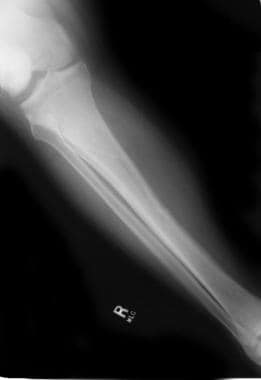Overview
One of the inevitable complications of spinal cord injury (SCI) is the associated osteoporosis that occurs predominantly in the pelvis and the lower extremities (see the image below).
The acute treatment of patients with spinal cord injury has always focused on the injury itself and on the immediate complications that subsequently arise. Bone loss as a consequence of spinal cord injury has been of secondary concern historically.
Osteoporotic femur in a patient with a spinal cord injury.
Osteoporosis in persons with spinal cord injury was first studied in relation to calcium metabolism and the associated hypercalcemia and renal calculi that followed. The differences between osteoporosis induced by spinal cord injury and other causes of bone loss (disuse), such as prolonged bed rest, space travel, and lower motor neuron disorders, have since become clearer. Newer technologies allow monitoring of osteoblastic and osteoclastic activity at the microscopic level, whereas modern radiographic techniques have allowed more refined studies to be undertaken at the macroscopic level.
A longitudinal cohort study by Rodriguez et al found the 4-year incidence of musculoskeletal morbidities (such as osteoporosis, sarcopenia, osteoarthritis, and fractures) to be 82.4% in adults with traumatic spinal cord injury, compared with 47.5% in adults without such injury. The 4-year incidence of osteoporosis in the two groups was 24.0% and 6.2%, respectively. The report included over 9000 patients with traumatic spinal cord injury and nearly 1.5 million without.
See also Spinal Cord Injuries, Autonomic Dysreflexia in Spinal Cord Injury, Functional Outcomes per level of Spinal Cord Injury, Heterotopic Ossification in Spinal Cord Injury, Hypercalcemia in Spinal Cord Injury, Prevention of Thromboembolism in Spinal Cord Injury, Rehabilitation of Persons with Spinal Cord Injuries, and Spinal Cord Injury and Aging.

